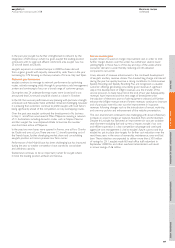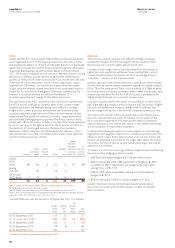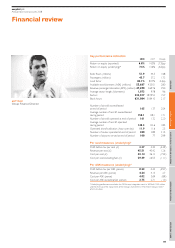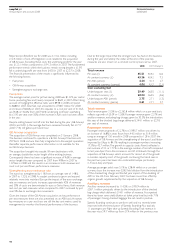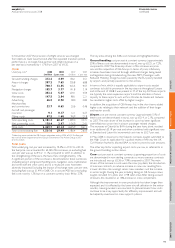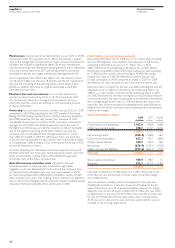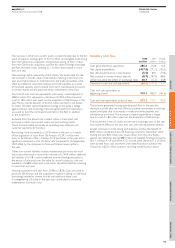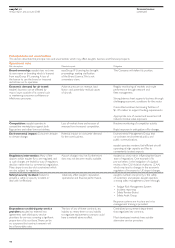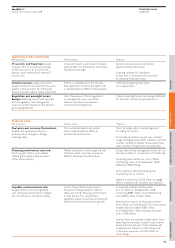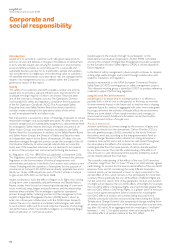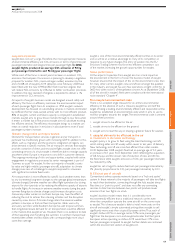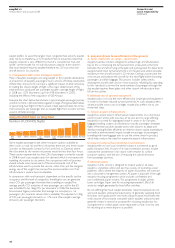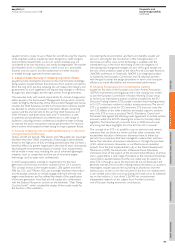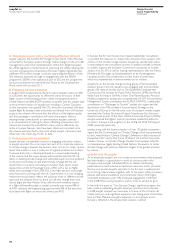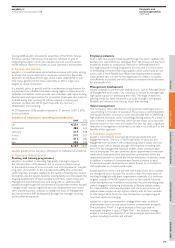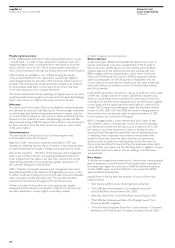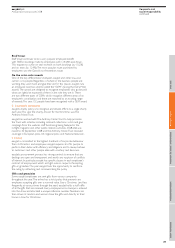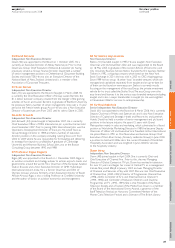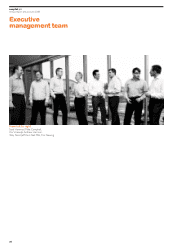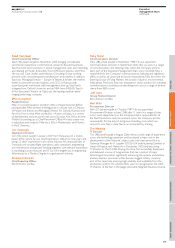EasyJet 2008 Annual Report Download - page 19
Download and view the complete annual report
Please find page 19 of the 2008 EasyJet annual report below. You can navigate through the pages in the report by either clicking on the pages listed below, or by using the keyword search tool below to find specific information within the annual report.
easyJet plc
Annual report and accounts 2008
OverviewDirectors’ reportReport on Directors’ remunerationFinancial informationOther information
17
easyJet is one of the most environmentally efficient airlines in its sector
and so will be at a relative advantage to many of its competitors in
response to any future changes. The entry of aviation into the EU
Emissions Trading Scheme may force less efficient competitors out
of the market, increasing the growth opportunities for easyJet.
Noise performance
At the airports it operates from easyJet also has a local impact on
the environment in the form of noise. The business model of easyJet
however ensures that the impact of this on the environment is less than
for many other carriers. easyJet’s new aircraft are amongst the quietest
in the industry and easyJet has very few operations at night (2300 hrs to
0600 hrs) when noise is of the greatest concern. As at September 2008,
all of the aircraft in easyJet’s fleet were compliant with the international
noise standard “Chapter 4”.
The easyJet environmental code
There is no accepted single measure for an airline’s environmental
efficiency. In the absence of such a measure, easyJet has set itself the
target of being a leading environmentally efficient and responsible airline.
easyJet has established an environmental code, which it aims to use to
monitor progress towards this target. The environmental code is centred
around three promises:
1. easyJet strives to be efficient in the air;
2. easyJet strives to be efficient on the ground;
3. easyJet aims to lead the way in shaping a greener future for aviation.
1. easyJet strives to be efficient in the air
A. Investment in the latest technology
easyJet’s policy is to grow its fleet using the latest technology aircraft,
whilst retiring older aircraft usually within seven to ten years of delivery.
New technology aircraft are more fuel efficient than older models.
At 30 September 2008, easyJet’s fleet had an average age of 3.4 years,
an increase of 0.7 years from September 2007, reflecting the acquisition
of GB Airways and the slower rate of induction of new aircraft into
the fleet. Since 2000 easyJet’s emissions of CO2per passenger kilometre
has reduced by 22%.
easyJet has set a target to reduce fuel burn per passenger kilometre by
3% (directly proportional to CO2per passenger kilometre) by 2011.
B. Efficient use of aircraft
Conventional airlines operate networks based on a “hub and spoke”
system. In these networks, the majority of passengers will take two flights
to reach their destination, connecting through the hub. easyJet always
flies direct, or “point to point”, and does not offer any connecting
services. A direct service between two points will produce lower
emissions than two flights via a hub.
easyJet’s business model means that it is considerably more
environmentally efficient than a traditional network carrier, even
when the competition operate the same aircraft on the same route
as easyJet. This is because easyJet is able to install more seats on the
aircraft and easyJet’s simple automated pricing allows easyJet to sell
significantly more seats than a typical European airline. Thus, each of
easyJet’s Airbus A319s on average carries 57% more passengers per
flight than the European norm and easyJet estimates that the typical
European airline operating an Airbus A319 would burn 27% more
fuel per passenger, compared to easyJet. Further details are contained
within the environment section of easyJet.com.
easyJet’s emissions
easyJet does not carry cargo. Therefore, the most appropriate measures
of environmental efficiency are CO2emissions in terms of grammes per
passenger kilometre and kilogrammes per passenger flight. In 2008,
easyJet flights produced an average CO2emission of 90.3g
per passenger kilometre and 98.6kg per passenger flight.
While most of the focus in recent years has been on aviation’s CO2
emissions, the European Commission is planning to develop a legislative
proposal for aviation NOx(mono-nitrogen oxides) emissions by the
end of 2008. All of easyJet’s A319 deliveries since February 2008 have
been fitted with the new CFM56-5B5/3 Tech Insertion engines that
will reduce NOxemissions by 25% due to better combustion processes.
In addition, the new standard of engines is expected to deliver a 1%
improvement in CO2emissions.
All aspects of easyJet’s business model are designed around safety and
efficiency. This focus on efficiency minimises the environmental impact
of each passenger flight. From its inception in 1995, easyJet’s network
development has focused on substituting services in markets dominated
by inefficient former state-owned airlines with its more efficient product,
80% of easyJet’s current and future capacity is employed in established
markets. easyJet aims to grow those markets through its low fares when
it enters a market but in the process easyJet aims to substitute existing,
less efficient services. The efficiency that easyJet brings to a market can
mean an overall reduction in emissions in absolute terms even if total
passenger numbers increase.
Climate change risks and opportunities
Demand for transportation services in general and air transport in
particular has traditionally grown with increasing GDP. In addition to this,
effects such as migration and the economic integration of regions can
drive demand in specific markets. The air transport services that easyJet
provides comprise of direct, point-to-point flights. easyJet does not offer
connecting services via a hub. easyJet is therefore able to reassign capacity
anywhere within Europe in response to any shift in customer demand.
The ongoing monitoring of risks and opportunities, coupled with active
engagement in regulatory processes by senior management is part of
“business as usual” for easyJet. As the vast majority of easyJet’s assets
by value are highly mobile (passenger aircraft), adaptation to climate
change poses less of a challenge to easyJet compared to a business
with significant immobile fixed assets.
Air transportation is more affected by specific local weather events than
by any incremental long-term changes to the average global temperature
(climate change). Extreme weather can affect flight operations by closing
airports for short periods or by reducing the effective capacity of airports
to handle flights. An increase in extreme weather events during the peak
summer flying due to climate change could increase disruption costs.
Conversely, milder winters in northern Europe may have the effect of
reducing the cost to airlines from de-icing activities and the disruption
caused by snow storms. If climate change alters the seasonal weather
patterns in Europe, so that northern Europe has stable, warm, dry
and sunny summers while Southern Europe has wet tropical summers,
then long-break leisure demand for air transportation could be affected
in the markets that easyJet serves. However, there is no evidence to date
of this happening and, if anything, the summers in northern Europe have
recently been wetter and less stable, with correspondingly more cloud
cover, than average.


